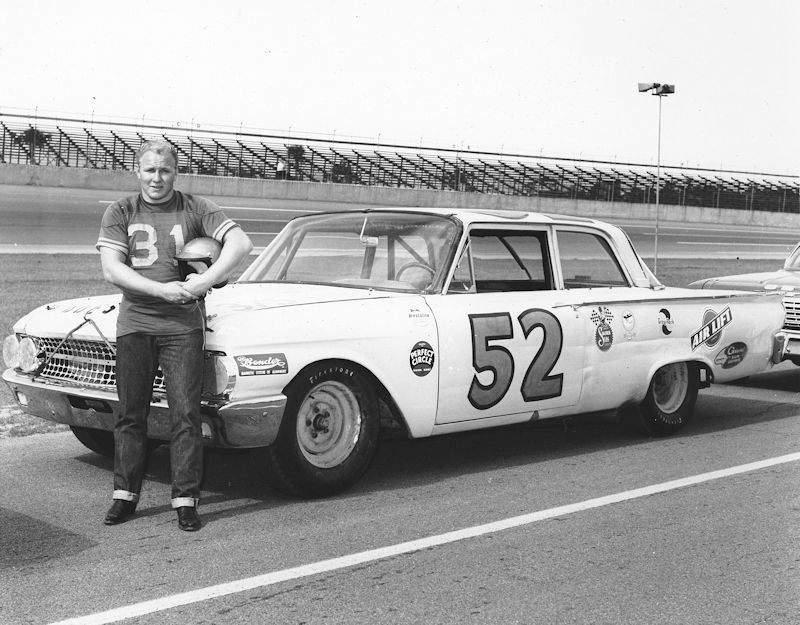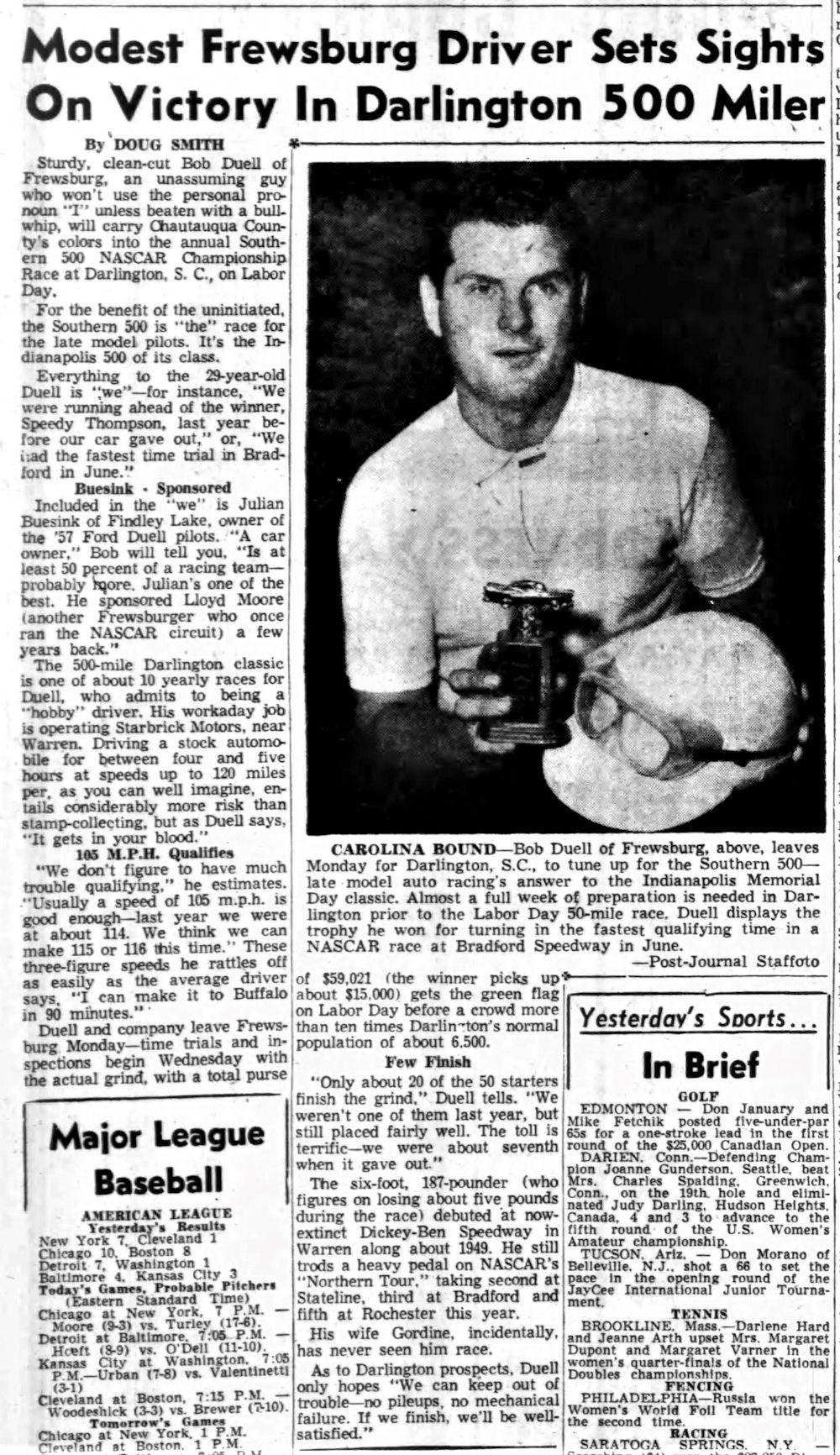Julian Buesink

1921–1998
Category
Auto Racing
Year Inducted
2009
As Moore once said, "If it wasn't for Julie, neither Bill or myself would have had the racing careers we enjoyed and for which we were recognized."
Legendary NASCAR drivers Richard Petty and Cale Yarborough sent letters to the Chautauqua Sports Hall of Fame acknowledging the "hardships and sacrifices Buesink made in the early years to make our sport what it is today."
Buesink was born in Mina on September 24, 1921, and was involved in the automobile industry his entire life owning Ford dealerships in Corry, Clymer, North East, and Westfield. He also owned a recreational vehicle dealership, as well as several used-car dealerships in the area.
read more...
Buesink's team approach to racing in the final race of the 1949 season became his modus operandi in his determined approach to 1950. He entered at least two cars in each of the 17 races on his NASCAR schedule.
The other interesting component to Buesink's 1950 racing plan was his use of several makes of cars. Unlike current NASCAR owners who use only one brand of automobiles, Buesink appropriated Oldsmobiles, Lincolns, Fords and Mercurys for the various lengths of tracks and surfaces his team faced.
Buesink earned NASCAR victories at Canfield (Ohio) with Rexford and at Winchester (Indiana) with Moore.
When the final NASCAR points were tabulated, Rexford was declared the Grand National Champion over Fireball Roberts and Lee Petty with Moore edging out Curtis Turner for fourth place. Rexford, from Conewango Valley, was just 23 and remains the youngest champion in NASCAR Sprint Cup history and its only champion from New York State.
Bill France, Sr., President of NASCAR, recognized Buesink as its National Champion Car Owner of 1950. Speed Age magazine honored Buesink for "outstanding achievement as stock car racing's Car Owner of the Year."
The best results for the Buesink team in 1951 were a pole position start for Rexford at Canfield, a third for Moore at Dayton, and a third for Jim Paschal at Macon, Georgia. Moore finished 11th in the 1951 NASCAR National Point Championship.
After two grueling seasons of following NASCAR, Julian began to curtail his racing efforts by adopting a "pick and choose" schedule. In 1952 he entered just 15 races with a single-car effort.
Although Buesink concentrated most of his efforts towards the newly formed Mid-American Racing Circuit (MARC) in 1953, he entered Bill Rexford in NASCAR races at Langhorne (10th) and Rochester (fifth).
Buesink did not participate in any NASCAR Grand National races in 1954.
In what turned out to be Moore's final year of competition, 1955, Buesink fielded cars for him at Raleigh (North Carolina) and Darlington. Tommy Thompson was Moore's Darlington teammate in a second Buesink machine.
Following the retirement of Moore, Buesink hired Warren driver Bob Duell. The duo competed in six NASCAR GN events in 1956 with their best showing being at the Monroe County Fairgrounds in Rochester. Duell set second-fastest time during qualifications and then had a fifth-place finish.
In 1957, Julian entered Duell in five NASCAR GN races. Their best effort was at the half-mile dirt oval Lincoln Speedway in New Oxford, Pennsylvania, where Duell qualified seventh. A broken rear-end relegated the team to a 13th-place result.
On June 12, 1958, Duell set fast time in Julian's Ford at the NASCAR-sanctioned grand opening of the New Bradford Speedway in Bradford, Pennsylvania. Duell finished in third place behind superstars Junior Johnson and Lee Petty. A month later, Stateline Speedway in Busti held its first and only NASCAR race and the Buesink-Duell team finished second behind Shorty Rollins, who would go on to win NASCAR Rookie-of-the-Year honors for 1958.
Duell drove Buesink's Ford in four NASCAR GN events in 1959 with his best finish being 11th at Weaverville, North Carolina. For the Southern 500 at Darlington, Buesink teamed Duell with an 18-year-old rookie by the name of Buddy Baker, son of Buck Baker. Buddy Baker, who along with his father, was named as one of NASCAR's 50 Greatest Drivers.
Buesink and Duell combined for six appearances on NASCAR's premier circuit in 1960. Their best effort was an eighth on the 2-mile road course at the Montgomery Air Base.
The next year Julian hired Tom Dill to drive his 1961 Ford at Daytona and Darlington. He also gave a 21-year-old daredevil from South Carolina, making his fourth ever NASCAR start, a ride in a Buesink machine at the Darlington Labor Day Classic. His name was Cale Yarborough. He would go on to be a three-time NASCAR GN champion and was named as one of NASCAR's 50 Greatest Drivers.
In 1962 Buesink and Yarborough teamed up for four NASCAR GN events at Daytona, Darlington and Atlanta. He finished 10th in one of two qualifying races at the 2-mile Daytona International Speedway.
Buesink competed for the final time in NASCAR GN competition in 1963. He had Yarborough in the seat at Daytona and Darlington. Julian tabbed Rene Charland, NASCAR Sportsman Champion in 1962, to drive in a Grand National consolation race at Daytona when Yarborough was too ill to drive. Unfortunately, Charland tangled with Ralph Earnhardt resulting in a massive crackup that eliminated many cars.
Buesink's last GN race was on May 11, 1963, at the Rebel 300 in Darlington where Yarborough came home 11th.
In 13 total years of NASCAR Grand National competition, Julian Buesink competed in 107 races, entering 156 cars, driven by 15 drivers. He earned two pole positions, won two races, had 29 top-five finishes, 64 top-ten results, and earned $42,841 in race purses. Most significantly was his GN Championship in 1950.
For 1961 Buesink, a former supervisor for the Town of Mina, became a car owner on the Stateline Speedway and Eriez Speedway circuit fielding a car that Marty Rater and Freddy Knapp shared. Knapp won his first-ever late model feature at Stateline on July 1, 1961, in Buesink's machine. Four weeks later Duell slipped behind the wheel and again put Buesink in victory lane for the 50-lap Mid-Season Championship.
Rater was again the Stateline-Eriez driver in 1962 scoring a season-best second place at Stateline on May 18. Pat Moore took a turn in the cockpit for 1963 scoring a season best third on July 6.
Paul Wilson gave Buesink a win at Stateline on June 6, 1964, followed by a second on July 25.
For 1965 Buesink utilized a two-car team at Stateline and Eriez employing Freddy Knapp to drive his No. 99 and adding Floyd Fanale near mid-season to steer the No. 9. Knapp scored two wins at Eriez, a 25-lapper and a 100-lap season finale. He also recorded six other top-three finishes in Buesink's Ford. Fanale rewarded Buesink with a Stateline win and then followed his teammate across the finish line in the Eriez season-ender.
Knapp and Fanale returned as Julian's drivers in 1966. Knapp took first place in a 50-lapper at Eriez, a 25-lapper at Stateline and repeated in the 100-lap Grand Championship race at Eriez. Meanwhile, Fanale added a win at Eriez.
Jim Scott led a single-car effort for Buesink in 1967. He grabbed two feature wins at Eriez and added five other top-three finishes. He finished second to Bobby Schnars in the final Stateline point standings.
The next year Buesink gave Scott a brand-new car, a 1968 Ford Torino, and Scott repaid his owner by having a monster year. He took 11 top-three finishes, including five feature wins.
Scott returned to Buesink's Torino Cobra in 1969 and together they produced seven top-three finishes, including wins at Eriez.
Paul Wilson gave Buesink a win at Stateline on June 6, 1964, followed by a second on July 25.
A Ford Mustang came from the Buesink garage in 1970 for Scott to drive and he had eight top-three results, including victories at Stateline and a score at Eriez.
Buesink came back with a two-car effort in 1971. Knapp and Scott combined for nine top-three finishes including a victory by Knapp at Eriez and Scott completed the year fourth in Stateline points and fifth on the S-E Circuit.
Knapp was the pilot for 1972 and 1973. He was first under the checkered flag twice at Eriez. Knapp garnered four other top-three results.
Following the 1973 season, Julian's racing career was essentially over. Although he would occasionally sponsor a car, as late as the 1990s, he refocused his attention and energy to his businesses.
Buesink's career totals on the Stateline-Eriez Circuit are 27 feature wins and 73 top-three finishes.
more about Julian Buesink
Memorabilia
Photographs
Publications
transcribed publications
- "Findley Lake’s Julian Buesink Hits Stock Car “Jackpot” in First Year – 1950." Circa 1951.
- "Julian Buesink." Speed Age Magazine, March 1951.
- . Circa 1951.
- Courson, Keith. "Leaving A Legacy Of Their Own." Post-Journal (Jamestown), February 16, 1997.
- "The long and winding road." Brown Thompson Newspapers (Union City, PA), June 1998.
- Anderson, Randy. "Julian Buesink - Stock Car Racing Pioneer." Circa 2009.
- Fryer, Jenna. "NASCAR HOFer Yarborough Dies At 84." Post-Journal (Jamestown), January 2, 2024.
scanned publications
select an image to enlarge
Videos
Websites
- "Julian Buesink." Racing Reference. Accessed January 26, 2019. https://www.racing-reference.info/owner?id=buesiju01.
- "Julian Buesink." Ultimate Racing History. Accessed January 12, 2021. http://www.ultimateracinghistory.com/racelist2.php?uniqid=6314.
- "Julian Buesink." Wikipedia. Accessed January 26, 2019. https://en.wikipedia.org/wiki/Julian_Buesink.
- "Julian E Buesink." Find a Grave. Accessed November 21,2022. https://www.findagrave.com/memorial/14418954/julian-e-buesink.
Of Special Interest
To support the nomination of Julian Buesink to the CSHOF, research on his auto racing career was compiled by Dennis Goggin. It is available for viewing here.
The additional financial assistance of the community is critical to the success of the Chautauqua Sports Hall of Fame.
We gratefully acknowledge these individuals and organizations for their generous support.





























































